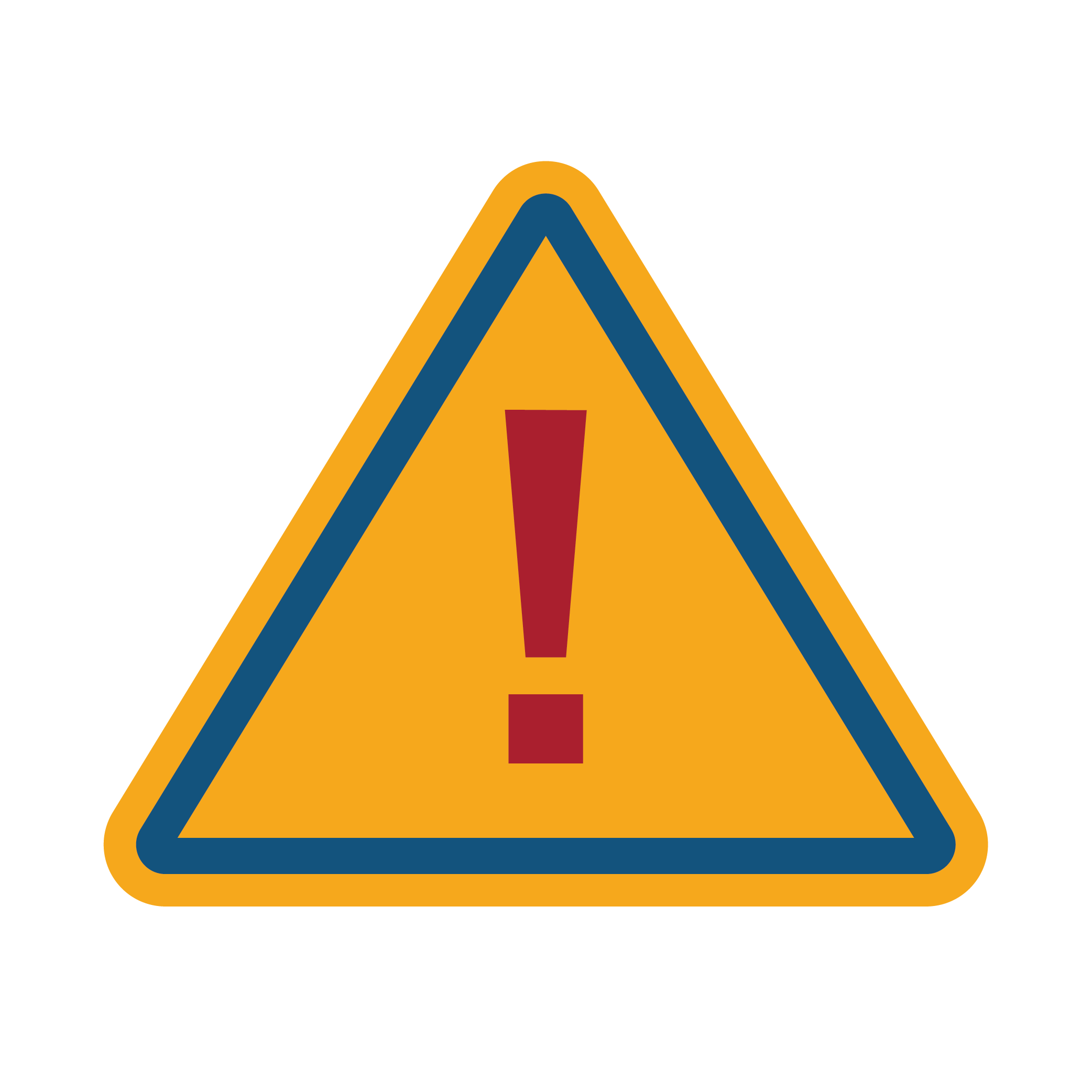Kiln Cautions
REV: 3/15/2025
Voir les instructions de prudence en français.
Ver las instrucciones de precaución en español.
Kiln Safety and User Responsibility
Basics
- L&L Kiln Mfg. Inc. provides safety guidelines to help users operate their kilns safely and effectively. Many of these precautions apply to all kilns and ceramic processes.
- By using or downloading content from this website, users acknowledge that improperly installed, maintained, or operated kilns and manufacturing systems can pose serious risks to worker safety, the environment, and product quality.
- Kilns operate at high temperatures and high voltage/amperage. If not installed, maintained, or used correctly, they can cause severe personal injury or property damage.
- Commercial kilns come with built-in safety and performance features. Tampering with or altering these features—whether by the user, employees, agents, or others—shifts all risk and responsibility solely to the user.
- Users must ensure that only properly trained personnel, with demonstrated competence and common sense, operate the kilns.
- The user is responsible for understanding and following all safety notices, installation, operation, and maintenance instructions provided by L&L Kiln Mfg. Inc.
Electrical Safety
Electricity is a wonderful utility, but can be dangerous if not approached carefully. There are three basic hazards that cause injury or death – shock, arc-flash, and arc-blast. It is important to remember that even a small amount of current passing through the chest can cause death. Most deaths occurring for circuits of less than 600 volts happen when people are working on “hot,” energized equipment – PLEASE DISCONNECT AND LOCK OUT ALL ELECTRICAL POWER BEFORE ATTEMPTING KILN REPAIRS!

ELECTRICAL HAZARDS
SHOCK
Electrical shock occurs when current flows through the human body. Electricity always seeks the path of least resistance to the ground. If a person touches a live wire, the current may pass through the nervous or vascular system and exit through another point of contact, such as a hand touching a metal pipe. This can disrupt normal electrical signals in the body, potentially stopping the heart or lungs, leading to severe injury or death.
ARC FLASH
An arc flash is an extremely hot explosion of plasma and gases that can cause severe burns and ignite clothing. Arc temperatures can reach up to 35,000°F—four times hotter than the sun’s surface!
ARC BLAST
An arc blast is a powerful pressure wave caused by an electrical arc. It can propel molten metal and hot gases at high speeds, causing serious injuries, destroying structures, or even knocking workers off ladders.
SAFETY PRINCIPLES
- Always de-energize equipment before servicing. Use lockout/tagout (LOTO) procedures in industrial settings to prevent accidental power restoration. Never work on live equipment unless absolutely necessary.
- Use the right tools. For example, use a fuse puller instead of a screwdriver to remove fuses.
- Wear proper protective gear. Use insulated gloves, rubber-soled shoes, and safety goggles or face shields to protect against arc flash and arc blast injuries.
- Ensure a safe working environment. Keep floors dry and maintain adequate space for safe operation.
- Minimize risk when working on live circuits. Avoid placing current across your chest—use one hand to handle test leads while keeping the other away from live components. Use a clamp for one lead when possible.
Stay vigilant—electricity is unforgiving!
ASSEMBLY
Leveling the Kiln
- Level the kiln during installation to ensure stability.
- Use thin metal shims under the legs if needed—never use wood or other combustible materials.
- Ensure the base is stable and does not wobble.
- An uneven kiln can cause instability in your ware and may lead to cracks in the kiln’s bottom and top.
- The kiln bottom is especially vulnerable when first setting up and bearing the kiln’s weight—proper leveling helps prevent damage.
Adjusting the Hinge Properly
- See the assembly instructions for your particular kiln.
- The hinge of any kiln must be adjusted so that the expansion caused by the heating process has room to expand.
- An improperly adjusted hinge can damage the rim and/or lid but also makes the brick of the rim compress against the brick of the lid.
- CAUTION: Do NOT attempt to disengage the spring hinge without first reading the detailed assembly instructions. The spring is under great pressure and could cause severe injury if it is removed under pressure. RELIEVE ALL SPRING TENSION BEFORE REMOVING THE LID!
- CAUTION: It is critical that the hinge bar sits in the bottom of the slot. This is to allow the lid to rise and lower slightly as the kiln heats and expands without putting stress on the lid's connection points and potentially damaging the lid.
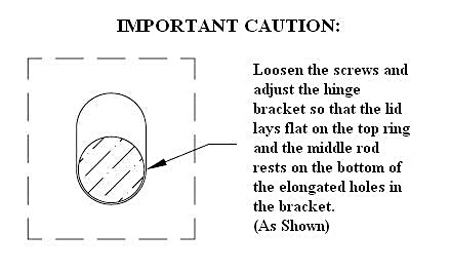 See this video on how to adjust the spring hinge properly
See this video on how to adjust the spring hinge properly
Thermocouples
- In automatic kilns, thermocouples must extend at least 1" (2.5 cm) into the kiln from the interior surface.
- The measuring tip must be exposed inside the kiln—if buried in insulation, it will read a lower temperature than the actual kiln temperature, potentially causing overfiring.
- Replace thermocouples when they are no longer providing accurate readings or are corroded.
Use the Supplied Kiln Stand
- Always use the supplied stand—never operate the kiln without it.
- Heat can transfer through solid materials, drying out combustibles and lowering their ignition point, increasing the risk of fire.
- Adequate airflow under the kiln is essential—never place a kiln directly on the floor.
- L&L kiln stands typically raise the kiln floor 8" (20 cm), except for the Plug-n-Fire model, which is 5" (13 cm).
- See this link about installing kiln on a wood floor.
INSTALLATION CAUTIONS
Clearances and Flammable Surfaces
Clearances
- Maintain 18" (46 cm) clearance from noncombustible walls/materials and 36" (92 cm) clearance from combustible walls/materials.
- Ensure ample room to open the kiln lid and access control panels around the kiln, typically 18" to 24" (46 cm to 61 cm).
- Keep surface temperatures near the kiln under 125°F (52°C) to reduce fire risk.
- Remember, even when you follow clearance and ventilation recommendations, the kiln gives off heat. Avoid locating it near things that can be affected by elevated temperatures. An example would be an electrical fuse panel, which you do not want to overheat.
- Be careful about enclosed spaces: In general, installing a kiln in a small confined space (such as a closet) is not a good idea.
Wall & Floor Materials
- Walls: Choose noncombustible materials like cement board, cinder blocks, or masonry. Consider installing a heat-resistant barrier if closer clearances are necessary.
- Floors: Install kilns on noncombustible surfaces (cement, ceramic tile, stone, slate, masonry) with at least 2" thickness, extending 12" beyond the kiln footprint.
- Never place kilns on wood flooring, carpet, or potentially flammable materials. Even cement floors benefit from the kiln stand for proper air circulation.
Use A Qualified Electrician
- Have all electrical installations performed by a licensed electrician or qualified technician to ensure safety and compliance with electrical codes.
- Risk of electric shock: Kilns operate at high voltages and amperages. Improper wiring or connections can expose users to serious or fatal electric shocks.
- Fire hazard: An improperly sized or installed circuit can overheat, potentially melting insulation, damaging components, or igniting nearby materials, leading to a fire.
- Sizing the supply wires requires detailed knowledge of the National Electrical Code.
- Circuit protection: A qualified professional will ensure the kiln is connected to a properly rated breaker, wire gauge, and grounding system, preventing overloads and dangerous faults.
- Code compliance: Licensed electricians follow national and local electrical codes, ensuring the installation is safe, legal, and up to standard.
- Electrical safety is critical—do not attempt DIY installation unless you have the necessary expertise.
Use Copper Wire for Hook Up
- Do not use aluminum wire for the final connection to the kiln.
- Kilns generate constant heat for extended periods, which causes wiring near the kiln to get hotter than in other appliances.
- Aluminum wire oxidizes quickly when heated, and aluminum oxide increases resistance, leading to dangerous overheating at the terminal connection.
- Overheated connections can cause a fire. Copper, by contrast, resists oxidation and maintains better conductivity.
- Local codes may allow aluminum wire to a sub-panel, but it must stay within its temperature rating even when the kiln runs at full power for long periods.
- Aluminum wiring was once common in homes but was phased out due to its tendency to expand under load, loosening connections and increasing fire risk.
- For safety, always use copper wiring in kiln circuits.
Power Cord Must Be Properly Rated
- All L&L power cords are rated for 105°C (221°F).
- Anything less than this can cause a malfunction and possibly a fire where the power leads connect to the control box.
- It is OK, and will not void the warranty, to remove the plug that comes with the kiln and directly wire it. However, the connection wires must be rated for a minimum of 105°C (221°F).
Protect the Power Cord from the Kiln Case
- Route the Power Cord (or electrical connection wires) away from the kiln so that it cannot touch the hot case of the kiln.
- Secure it so it can not move.
- If the cord touches the hot case, it could melt and cause a short circuit and/or fire.
Don't Use an Extension Cord
- Never use an extension cord with your kiln.
- Voltage drop risk: Extension cords reduce voltage over distance, which can cause the kiln to underperform or overheat wiring.
- Overheating and fire hazard: Standard extension cords are not rated for the high amperage that kilns require. Overloaded cords can melt insulation, damage connections, and start fires.
- Direct connection is safer: Position the outlet close enough for the kiln’s supplied power cord to plug in directly.
- Hardwiring required for high-power kilns: Kilns over 48 amps and some three-phase models do not have power cords and must be wired directly to the power supply.
- Warranty and safety compliance: You can directly wire any kiln without voiding the warranty or affecting the UL499 rating. Use 105°C-rated wire for safe installation.
Keep Kiln Dry & In Protected Space
- The kiln must be kept dry.
- It is best to keep it in an enclosed room away from inclement weather. The installation instructions provide specific details.
- Note that our warranty does not cover damage from corrosion and electrical damage caused by inclement weather.
- Water in contact with a kiln can cause an electrocution hazard.
- If you keep a kiln outside (even in an arid environment) and cover it with a tarp to protect it from rain, you could still cause corrosion from the dew that forms on the cold metal surface of the kiln in the morning.
Sprinkler Cautions
- If your kiln room has a sprinkler system, ensure the sprinkler heads are properly rated and positioned to prevent accidental activation during normal kiln operation.
- Check temperature ratings and locations to avoid triggering sprinklers under normal firing conditions.
- Monitor the system when the kiln reaches peak temperature, especially when ventilation is off or doors are closed, as heat can build up.
- A triggered sprinkler can cause serious damage to the kiln and the premises, especially if no one is present.
- Use the highest temperature-rated sprinkler head in the kiln room or ensure it is not positioned directly above the kiln.
- Avoid placing sprinkler heads over the kiln, as localized heating (such as from an open lid or door) could cause accidental activation.
- Consider installing a temperature alarm to alert personnel if the room exceeds 125°F, preventing sprinkler activation due to high ambient heat.
- Ensure adequate ventilation to manage heat buildup and maintain a safe environment.
- See this link to calculate ventilation requirements.
Keep A Fire Extinguisher Near the Kiln
- Keep an adequate fire extinguisher near the kiln and check it regularly.
- Consult local fire authorities for any specific requirements, such as sprinkler systems or automatic foam extinguishers.
- Use a fire extinguisher rated for electrical fires—an ABC-rated extinguisher is recommended.
Check Temperatures Around Kiln
- Check temperatures around the kiln when it is operating at high levels to ensure it is not creating an unsafe condition.
- Surfaces that remain below 71°C (160°F) are generally considered safe, meaning they will not spontaneously catch fire. However, prolonged exposure to heat can dry out materials, lowering their ignition point over time.
For safety:
- Keep surrounding surfaces below 160°F (71°C) during operation.
- Use heat-resistant barriers (such as cement board) if surfaces may exceed this temperature.
- Maintain adequate clearances and ventilation to minimize heat buildup.
GENERAL ENVIRONMENT CAUTIONS
Ventilation is Essential
- Kilns generate harmful fumes when firing ceramics.
- Fumes include carbon monoxide, sulfur oxides, hydrogen fluoride, and metal vapors (all of which can be very toxic).
- Install the kiln in a well-ventilated area.
- Never operate in an enclosed space like a closet without good ventilation.
- Aside from issues of ventilating the fumes from the firing, the heat buildup in an enclosed room could present a significant fire hazard. See the INSTALLATION cautions.
- Kiln fumes, salt air, or other environmental conditions can cause severe corrosion.
- Good venting can minimize these problems.
- Ventilation must be to the outside.
- Be careful not to locate the outlet of the vent near an open window (so that it could get sucked back into the building).
Helpful Tips
- Ventilation Guidelines
- See this for how to calculate ventilation requirements.
- Where should I put my kiln?
- Corrosion and ventilation
- If you are using a hood-type vent (like the Vent-a-Kiln), do you need a kiln vent (like the Vent-Sure) also?
Ambient Temperatures
- The kiln should operate in an environment that is between -18°C (0°F ) and 38°C (100°F).
- Note that the control, if set up for degrees centigrade, may give you an error code if the room temperature drops below 0°C (32°F). The Genesis, DynaTrol, and most other controls do not handle negative numbers.
Keep Flammables Away from the Kiln
- Do not put sealed containers or combustible materials such as solvents, paper, or rags in or near the kiln.
- The kiln elements, when hot, could act as an igniter of flammable fumes.
- An explosion or fire could result.
Surface is Hot and Can Cause Burns
- The kiln surface can be extremely hot: up to 260°C (500°F).
- You can be severely burned if you touch the hot surface.
- Display a sign near the kiln that warns everyone of how hot the kiln is.
Keep Children & Animals Away from the Kiln
- Keep children, animals, and unqualified adults away from the kiln.
- Kilns pose risks from heat, electrical hazards, fumes, and fire.
- Ensure proper ventilation and fire safety measures.
- In schools or shared spaces, place kilns in restricted areas where children cannot access them unsupervised.
Tripping Hazards
- Be sure to remove tripping hazards near the kiln.
- In particular, keep the kiln cord out of traffic areas.
Clothing to Avoid
- When working around a hot kiln, be careful of the kinds of clothes you are wearing.
- Some clothes could catch on fire if they touch the hot surface of a kiln.
- Also, avoid loose-fitting clothes that could catch on the kiln.
Practice Good Hygiene
- Clay contains silica dust, which can be harmful (see silica caution), and some glazes contain heavy metals such as lead, cadmium, and copper.
- While this caution is outside the scope of kiln safety, it is worth mentioning here.
- Keep your room clean and your kiln clean.
PREFIRING CAUTIONS
Kiln Wash Contains Silica
- Long-term exposure to silica dust can cause lung damage.
- Check your supplier's Material Safety Data Sheets (MSDS) for safety information.
- Use caution when handling dry powders and cleaning kiln shelves to minimize dust exposure.
- Wear a NIOSH-approved particulate respirator (e.g., #TC-21C-132) and ensure proper ventilation.
- Respirators are available from safety supply stores.
Proper Use of Kiln Wash
- Ensure the kiln floor and the tops of shelves are coated with kiln wash to protect against melting glaze and ceramics.
- Do not coat the undersides or sides of shelves.
- Never apply kiln wash to brick sides or element holders, which can damage the elements.
- If using a kiln sitter, apply kiln wash to the cone supports, but not the sensing rod, for accurate cone action.
- Remove old kiln wash and reapply before each firing or when it starts to chip.
- Kiln wash is not supplied by L&L—purchase from a local ceramic dealer.
Use Kiln Wash on the Cone Supports
- If you have a kiln sitter, put kiln wash on the cone support (not the sensing rod) for accurate cone action.
- This will keep the cones from sticking when they bend.
- We recommend cleaning off the old wash and reapplying the new wash each time you fire.
Do Not Use Silica Sand
- We recommend not using silica sand in the kiln (often used as a work support medium).
- The silica can attack and reduce the life of the elements and thermocouples. (Details: At high temperatures, silica can combine with aluminum oxide to form compounds like aluminosilicates, which may attach to the elements' surface. This can degrade the protective oxide layer, increasing oxidation and corrosion, and reducing element life. Additionally, silica can potentially melt and adhere to the elements at high enough temperatures, further exacerbating the wear.)
- We recommend alumina oxide or zirconia oxide sand.
- If you use silica sand, vacuum the kiln after each load.
Store Shelves in a Dry Location
- Shelves can absorb moisture.
- This can cause them to explode when fired.
Do Not Use Cracked Shelves
- Cracked shelves can fail in the middle of a firing, causing the whole load in your kiln to collapse.
Never Fire Moist Greenware
- Never load moist greenware or pots into the kiln.
- Trapped water can turn to steam and cause explosions, damaging the kiln interior.
- To remove moisture, Use a dry-out segment in your bisque firing program at 66°C (150°F).
- Even if the piece looks dry, it may still contain water. If it feels cool against your wrist, it likely has too much moisture to fire safely.
Do Not Fire Toxic, Flammable, or Unknown Materials
- Avoid firing plastics, organic materials, bakeable modeling clay, mothballs, and other non-ceramic substances in the kiln. Many materials release toxic fumes or combust uncontrollably when heated.
- Rocks, marbles, and cement can explode at high temperatures.
- Only fire ceramics, glass, and metal from a reputable source—constantly research how a material reacts to heat. The user is solely responsible for safe firing.
- Kilns are not designed for hazardous materials.
- Introducing propane, wood, charcoal, or other materials to create a reduction atmosphere can be dangerous. Under certain conditions, the air-to-fuel ratio can cause an explosion, leading to serious injury or death.
- A reducing atmosphere can damage kiln elements, causing premature failure by breaking down their protective oxide coating.
- Carbon-based materials decompose at high temperatures, releasing poisonous carbon monoxide and flammable hydrogen.
- Flammable gases auto-ignite above 1400°F, creating additional fire and explosion risks.
Do Not Fire Tempered Glass
- Tempered glass can explode when fired.
Caution With the Use of Wax
- When you heat wax (in wax resist and lost wax processes) it will volatilize and potentially condense in the cooler ventilation ducts.
- This can cause a fire hazard over time because the wax is flammable.
- Depending on how the vent motor is mounted, the wax can also gum up the vent motor.
- If you use these processes, it is entirely up to you to engineer and monitor the safety of the installation.
- Using wax will void the warranty of the vent system.
LOADING & UNLOADING CAUTIONS
Viewing Into The Kiln
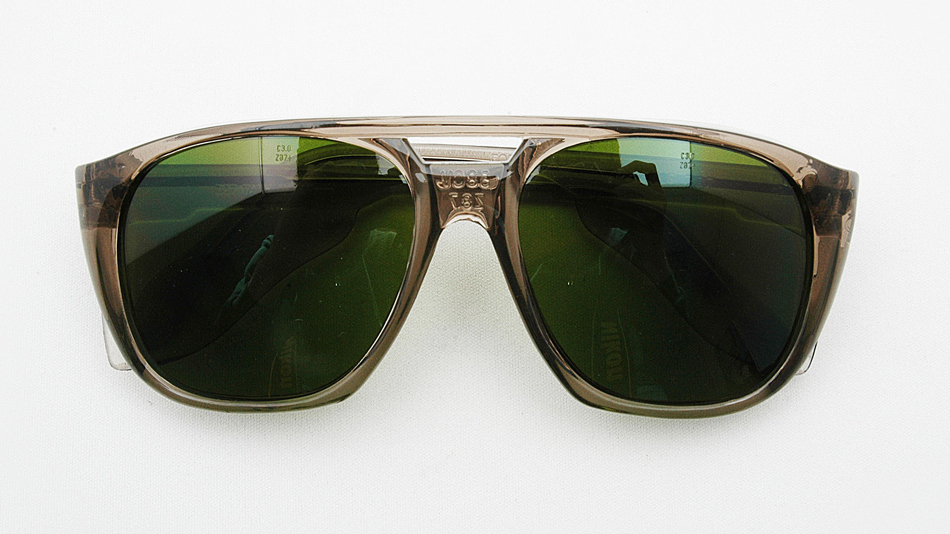
- Use dark glasses (shade 1.7 to 3.0) when looking inside the kiln through peepholes or the door to protect your eyes from infrared radiation and potential explosions. Regular sunglasses do not provide adequate protection.
- Wear heat-resistant gloves when handling peephole plugs or the kiln door, as they can cause burns.
- Never open the kiln lid while it is on, except for controlled troubleshooting tests. Opening the lid while powered can cause electrocution, and the warranty does not cover cracks from propping it open.
- Always wear heat-resistant gloves when opening a hot lid; never open the lid if the kiln temperature exceeds 121°C (250°F).
Keep Lid Closed When Kiln Is Not In Use
- Keep lid closed when not operating the kiln.
- Otherwise, the lid's weight over time may force the hinge and stainless wrap to move down.
- This will affect how the lid closes and may cause the lid to crack.
- It will also keep the kiln cleaner by keeping dust out.
- If the kiln gets turned on accidentally, an open kiln could present a fire hazard.
Do Not Store Anything On Lid
- Do not use the lid as a storage shelf.
- The lid could crack.
- Also, this practice could lead to a fire if you accidentally leave combustible materials on the lid.
Turn Off Power While Loading
- Turn off the power when loading or servicing the kiln.
- If the kiln is on, accidental contact with the elements can cause electrocution.
- In institutional or industrial settings, use a fused disconnect switch with a lockout device to prevent someone from turning on the kiln while another person is working on it.
Do Not Open the Door Above 250°F
Do not open the kiln door until it cools to 250°F (120°C) to avoid burns from the handle or radiant heat.
- Even at this temperature, use heat-resistant gloves when opening the door.
- Some users prop the lid 1” to 3” open at the start of firing for ventilation if no downdraft vent is installed. If doing so, be aware of the risks: heat exposure, live electricity, fumes, and possible lid cracking. Take proper precautions to protect yourself and the kiln.
Do Not Unload Kiln While Hot
- You may burn yourself.
- You may harm your work.
Secure Lid While Loading or Unloading
- LOCK THE LID IN PLACE with the spring-loaded plunger pin on the hinge's side.
If You Have a DaVinci Counterbalanced Lid
- Be sure to LOCK THE LID IN PLACE with the safety hooks when in the up position.
- There is one on each side of a DaVinci kiln. Use both chains.
Be Careful of Sharp Objects
- Stilt marks and other sharp protrusions can cut you.
- Remember that the glaze is like glass.
- Wear safety glasses while grinding or knocking off stilt marks.
- Check the shelves for broken bits of glaze that may have attached to the shelves. These can be like shards of glass that can cause a serious cut.
FIRING CAUTIONS
Do Not Fire Kiln Above 2350°F (1290°C, Cone 10)
- Most L&L kilns are rated for use to 2350°F (1290°C, Cone 10).
- One exception is the JH Series kilns, which are listed to 2400°F (1315°C, Cone 12)
- The rating of the kiln is listed on its data nameplate, normally affixed to the control panel.
- DO NOT FIRE ANY HIGHER THAN THIS or hold for extended periods at those temperatures.
- The elements, element channels, and firebrick could melt.
Attend The Firing
- We recommend attending the kiln while firing.
- NO AUTOMATIC SAFETY DEVICE IS FOOLPROOF! BE ESPECIALLY CAREFUL ABOUT ATTENDING THE KILN WHILE IT IS SUPPOSED TO SHUT OFF. (The Delay feature in automatic kilns gives you control over this).
- The controller controls temperature: it is not a safety device.
- If you have a manual kiln with a Kiln Sitter, PLEASE BE EXTRA CAREFUL! Kiln sitters can be unreliable because of the moving parts, dirt or clay that can get into the tube, the way cones are placed on the tube, corrosion, etc. DO NOT FIRE THIS KILN UNATTENDED WHEN THE KILN IS SUPPOSED TO TURN OFF AND LEARN HOW TO USE THE TIMER BACKUP. Neither L&L Kiln Mfg., Inc. nor Edward Orton Jr. Ceramic Foundation warrants the kiln or kiln sitter against damage caused by overfiring. ALMOST ALL OVERFIRED KILNS WE SEE ARE FROM A MALFUNCTION OF A KILN SITTER. We highly recommend firing all manual kilns with witness cones that you can see through the peephole and/or a pyrometer so you know what is happening inside the kiln.
Make Sure Your Kiln Sitter Is Adjusted
- If you have a manual kiln (or the Kiln Sitter backup on an automatic kiln) be sure it is properly adjusted.
- See the Kiln Sitter instructions.
- Overfiring could result.
- Note that the kiln sitter could have gone out of adjustment during shipment. Do NOT assume that it is adjusted when first firing the kiln.
- The tube assembly should be replaced if it gets overly corroded or contaminated with condensed glaze or other materials. Dawson recommended checking the pivot point for corrosion and sluggishness every 6 to 12 months.
Understand Your Control
- Become familiar with either the control (if you have an automatic kiln) or the Kiln Sitter (if you have a manual control or have that as your backup control).
- Do this before operating the kiln.
Program Review on Automatic Kilns
- Review the program before firing to ensure the correct profile is programmed.
- You may pick up an important mistake and save a whole load.
- For the Genesis Control, see this page and search for Review Program.
- For the DynaTrol Control, see this page and search for REVIEW SECTION.
POST FIRING CAUTIONS
Check For Glaze and Ceramic Chips
- Check element holders and walls for glaze, clay chips, or anything that could melt at a high temperature.
- A rapid failure could result if melted clay or glaze comes in contact with an element. The molten material traps the heat radiating from the element and raises the wire's surface temperature. The temperature will quickly pass the maximum recommended temperature for the wire and burn it through it.
- To clean holders, a good shop vacuum will handle dust and loose crumbs. A very gentle chisel or grinder may help with glaze contamination on element holders, but remember that the elements are quite brittle when cool.
- Replace the contaminated channel if you cannot clean it.
- Remove any glaze that has splattered on the firebrick or shelves. (USE SAFETY GLASSES WHEN DOING THIS BECAUSE GLAZE CAN BE LIKE BROKEN GLASS.) Vacuum afterward. Note about vacuuming: it is possible to build up a strong static electricity charge when you are vacuuming. If this somehow discharges into the control, it can ruin the electronic circuit. Ensure the vacuum is grounded and periodically touch some grounded metal surface away from the kiln to discharge the energy.
GENERAL MAINTENANCE CAUTIONS
Electrical Safety for Maintenance
- Shut off the kiln when servicing it unless you are doing a live test that specifically calls for power. If you are in an institutional or commercial setting, use a lock out/tag out procedure. Unplug if the kiln includes a plug; if not, turn off at the closest circuit breaker or fused disconnect.
- You do not need the kiln powered when testing ohms for an element circuit.
- The elements carry high voltage and can electrocute you. Many of the tests described in the troubleshooting manual are performed under power. They should be done ONLY by someone familiar with electrical safety, such as an electrician or trained maintenance person.
- You are safe as long as the kiln is unplugged or turned off at the fused disconnect switch or circuit breaker (and checked with a reliable meter to be sure).
READ THE FULL CAUTION ABOUT ELECTRICAL SAFETY
Shut Off the Kiln At the Disconnect or Circuit Breaker
- It is possible for electrical contacts on contactor relays to fuse.
- If this happens, power will continue to flow to the elements, and your kilns could overfire even though everything on the kiln is shut off.
- After turning off the kiln itself, you should disconnect it from the circuit breaker or fused disconnect switch.
Check Wires & Terminals
- Check wires for deterioration or oxidation.
- Replace any that seem brittle or where the wire insulation has deteriorated or fallen off.
- Check terminals for oxidation (discoloration).
- If you are near salt air or notice corrosion on the stainless exterior of the kiln for whatever reason (like certain fumes generated by your work), do this far more frequently.
- Check the power connection terminals in the kiln and control box for tightness. Be sure to do this with the kiln's power disconnected (unplugged). If these terminal connections get loose, heat can be generated (because the electrical resistance increases), which can cause a fire.
- Check thermocouple connections for corrosion, tightness, and oxidation. A bad thermocouple connection can affect the accuracy of the temperature reading, which could cause overfiring.
CAUTION: Configure Replacement Control
WHEN REPLACING A DYNATROL OR GENESIS CONTROL: CHECK THE CONFIGURATION OF THIS REPLACEMENT CONTROL TO MAKE SURE YOU DON’T MELT YOUR KILN!
A replacement DynaTrol or Genesis control will typically have our standard configuration for Type K thermocouples and 3 zone control. THIS MAY NOT MATCH YOUR KILN! Here is what you need to check:
CHECK THE THERMOCOUPLE TYPE
- This is the MOST IMPORTANT thing to do. If your kiln has type S thermocouples and the control is set up for type K thermocouples, you could overfire the kiln to the point of a complete melt-down.

- Type K thermocouple extension wire (the wire from the thermocouple to the control) is either yellow or brown. Type S extension wire is green (in the USA).
- See this for more information on thermocouple wires and hookup: check-polarity-thermoocuples-and-lead-wires
Type K thermocouples typically look like this.
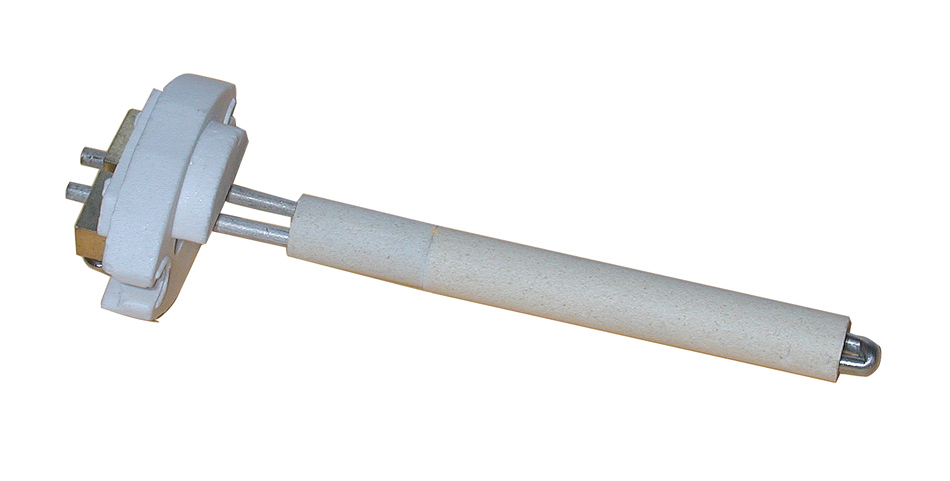
Type S thermocouples typically look like this.
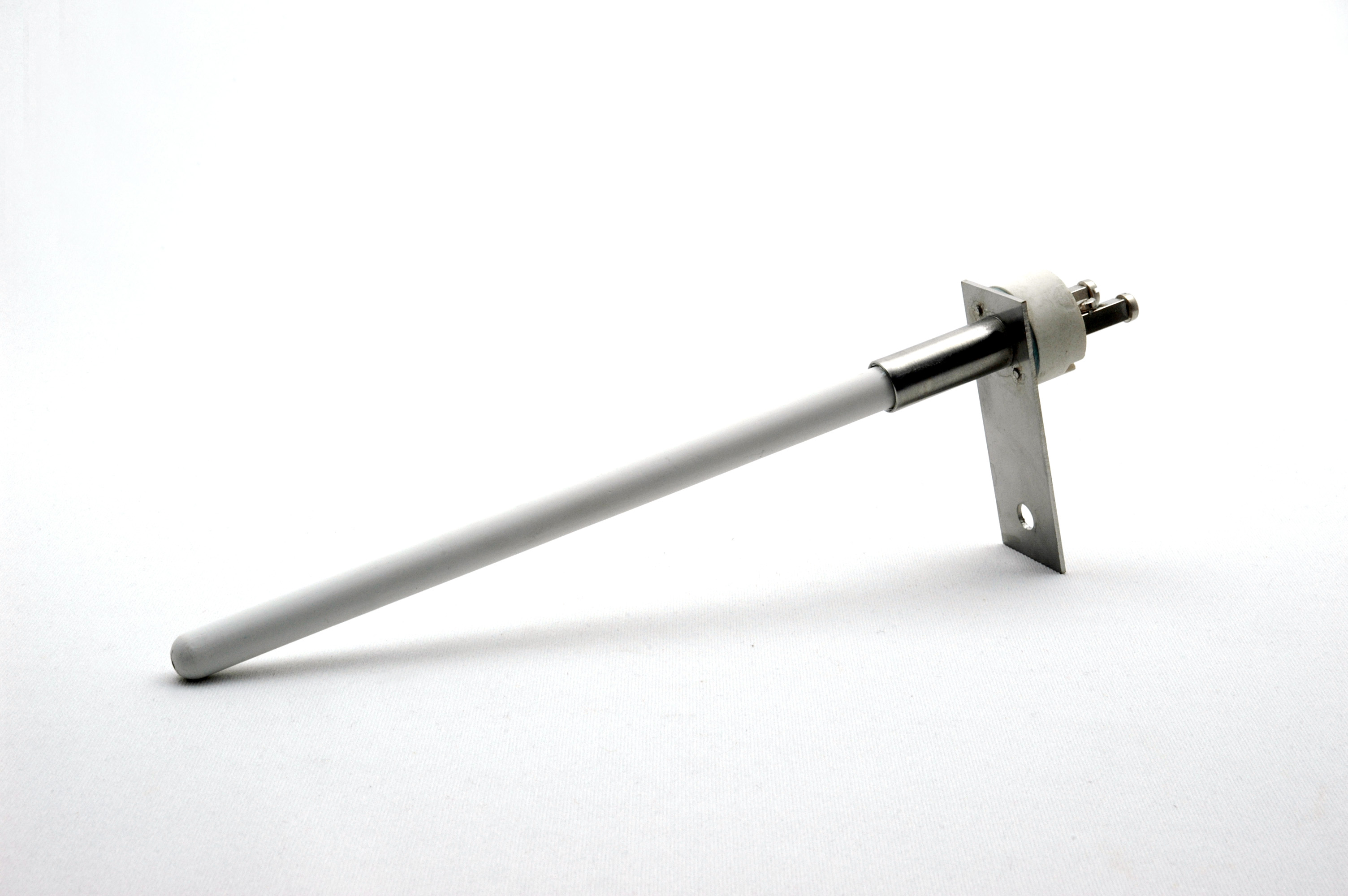
HOW MANY ZONES DO YOU HAVE?
- Count the number of thermocouples you have – that should equal the number of zones configured in the DynaTrol.
- To change the number of zones, see these instructions: hotkilns.com/hidden-menu-dynatrol
- For DynaTrol, see this: hotkilns.com/change-single-zone
- For Genesis, see this: hotkilns.com/genesis/number-of-zones
CHECK THE THERMOCOUPLE OFFSET
- If you have Type S thermocouples, then the Thermocouple Offset should be set at 00.00.
- If you have Type K thermocouples and a ceramic protection tube with a closed end, the Thermocouple Offset should typically be set for 00.18 (18 Degrees F).
- If you have Pyrocil sheathed Type K thermocouples or 14-gauge or 8-gauge thermocouples without a ceramic protection tube or our newer open-end ceramic protection tube, then the Thermocouple Offset should be set for 00.00
- How to change Cone Offset: change-cone-offset
HOW TO CHANGE THE CONTROL IN THE KILN
- See this video: replace-control
Check the Temperature of the Cord
- Occasionally check temperatures of the main power cord at the main receptacle and the main kiln breaker while the kiln is at its hottest.
- If these are hotter than usual, it could be a sign of a loose or corroded connection, or possibly the wire gauge used in the power hook-up is the wrong size for the amount of current being drawn by the kiln.
- Immediately diagnose and fix this because it could cause a fire.
- Also, check the temperature of any other cords on the kilns (such as element jumper cords).
Check For Corroded Connections
- When replacing infinite zone switches (and other electrical components), replace the electrical connectors.
- At the very least, check for discoloration (an indication of oxidation).
- Electrical connectors will typically oxidize over time where there is heat, which can cause further overheating of the part at the connection point. This can, in turn, lead to early failure of the part, wire, and connector.
- Ensure the new connectors are firmly crimped onto the wire.
The Wrong Parts Can Be Hazardous
- Non-L&L elements can present a potential hazard to the kiln or cause a fire (by drawing too much amperage).
- The wrong type of fuse, relay, switch, or other component can cause a fire or other hazardous condition.
- An improperly rated cord can cause a fire.
ROLLING STAND CAUTIONS
- Move the kiln to a safe position BEFORE turning on.
- Lock all Casters firmly. Make sure the kiln is level and will not move.
- Hot surfaces of the kiln must be a minimum of 12” / 30 cm from any wall (18”/ 46 cm is preferable) and 36”/ 92 cm from another kiln that is firing. Make sure the floor is not flammable.
- Ensure no flammable materials are within 18” of the kiln (the sides, over and under).
- Plug or connecting wires must not become a trip hazard.
- Make sure the plug is firmly seated in the outlet and is not affected by moving the kiln.
KILN MODIFICATIONS CAUTIONS
Coatings
- We do not recommend any coatings for the elements.
- Using ceramic coatings will void the warranty on the elements and potentially the firebrick or element holders if they contaminate them.
- We have not adequately tested these coatings, so we can only say, at this time, that any trouble resulting from using ITC and other coatings must be at the user's risk.
- We do use a proprietary coating on all our firebrick that improves firebrick life and reduces dusting.
Other Modifications
- All customer modification is made solely at the customer's risk.
- Modifications will void the warranty.
- L&L takes no responsibility for hazardous conditions created by unauthorized modifications.
- Any authorization for an engineering change must be in writing from the factory.
Do Not Overinsulate the Kiln
You can add insulation to the bottom and, to some extent, the top of the kiln.
- Adding too much insulation to the lid can weaken it, as it relies on cooling for structural strength. This may cause cracking or collapse.
- Never insulate around the perimeter of a sectional kiln. This can trap heat in the wiring boxes, creating a fire hazard.
- The stainless-steel wrap that holds the kiln together expands with heat, and added insulation may loosen the kiln’s structure.


